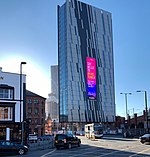River Street Tower

River Street Tower (also known as the Downing Tower after its developer) is a high-rise residential tower in Manchester, England. The tower is situated immediately north of the Mancunian Way on land which was formerly occupied by a concrete car park frame from 2005 to 2018. A 125 m (410 ft) tower was originally approved in October 2012. However, the scheme never materialised and the land was sold to new owners. A revised scheme for the site was approved in 2017 for a 32 storey, 92 m (302 ft) high-rise tower, comprising 420 apartments targeted at the student accommodation market. The unfinished concrete frame was demolished in May 2018 and construction commenced on the tower in summer 2018. As of 2023, River Street Tower is the joint 19th-tallest building in Greater Manchester with 1 Spinningfields.
Excerpt from the Wikipedia article River Street Tower (License: CC BY-SA 3.0, Authors, Images).River Street Tower
Mancunian Way, Manchester Hulme
Geographical coordinates (GPS) Address Nearby Places Show on map
Geographical coordinates (GPS)
| Latitude | Longitude |
|---|---|
| N 53.470824 ° | E -2.249284 ° |
Address
Mancunian Way
Mancunian Way
M15 5GW Manchester, Hulme
England, United Kingdom
Open on Google Maps








